19 FEBRUARY – 04 MARCH 2025
By Dominic Rollinson
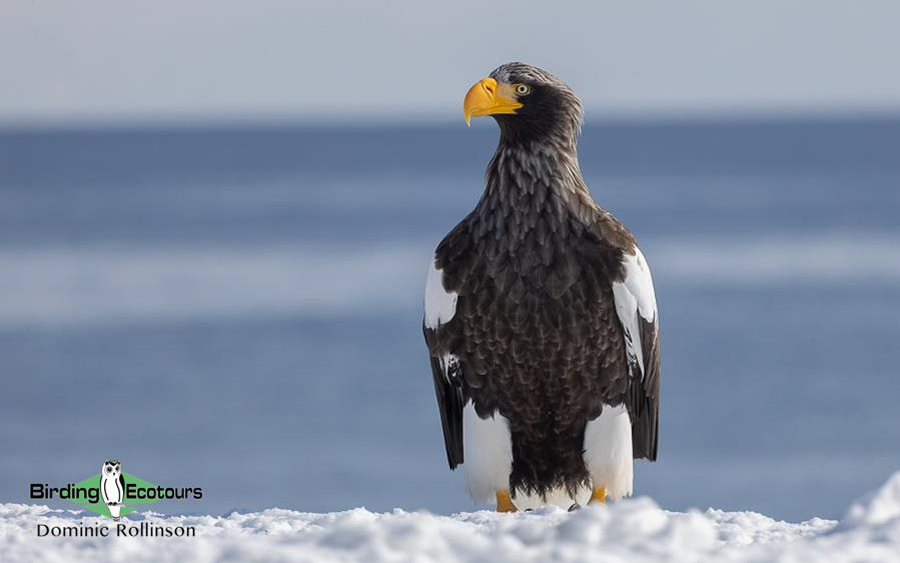
The massive Steller’ Sea Eagle showed amazingly well for us in Hokkaido.
Overview
This Japan birding tour took place during the winter, when large numbers of iconic birds including cranes, sea eagles and waterfowl accumulate, which all make for a wonderful birding experience. While birding in Japan we visited several bird sanctuaries and reserves which are set up to preserve birds and other wildlife and it was encouraging to see how proud communities were to host and conserve the local wildlife. Another highlight of visiting Japan is to experience Japanese culture and cuisine, and we got a taste of this as we spent a couple of nights at a traditional onsen (hot spring) on Hokkaido.
The tour moved from south to north and covered the three largest Japanese islands (Kyushu, Honshu and Hokkaido) and included a ferry trip out to the Izu Islands, off Tokyo. Our rough schedule included five days on the southern island of Kyushu, where we enjoyed masses of wintering Hooded and White-naped Cranes at the Izumi Crane Centre, before we spent four days on the main island of Honshu. On Honshu we spent an enjoyable morning with the ‘snow monkeys’ (Japanese Macaques) of Jigokudani, before birding the forests of Karuizawa, and then watching a massive Baikal Teal flock which was a sight to behold! We then caught a plane north for a few magical days on Hokkaido. The weather was just about perfect for us here, and we enjoyed such highlights as Blakiston’s Fish Owl, Steller’s Sea Eagle, Red-crowned Crane and even a small pod of Killer Whales (Orca). The tour ended back in Tokyo after an overnight ferry trip to the Izu Islands; unfortunately, due to the bad weather, we were unable to disembark at Miyake Jima to look for the specials, however, the unbelievable pelagic birding more than made up for this.
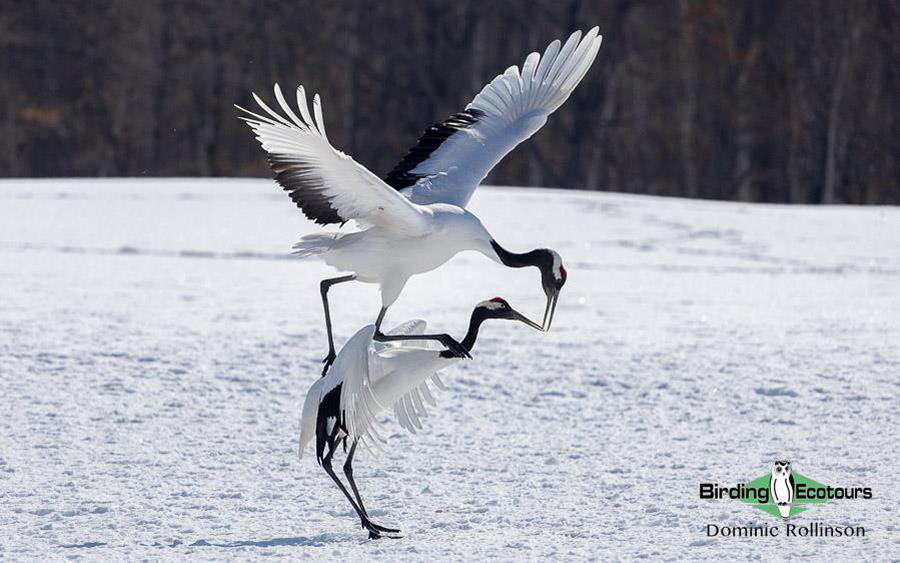
Red-crowned Cranes, here a pair displaying, were one of the many highlights of this Japan birding tour.
As with most winter birding tours in higher latitudes, the species diversity was on the lower side, however, in Japan it’s quality over quantity and we ended up finding most of our target birds including some definite dream birds. Some of the highlights of the tour included Baikal Teal, Harlequin Duck, Stejneger’s Scoter, Copper and Green Pheasants, White-naped, Hooded, Common and Red-crowned Cranes, Solitary Snipe, Rock Sandpiper, Saunders’s Gull, Japanese Murrelet, Laysan, Black-footed and Short-tailed Albatrosses, Tristram’s and Leach’s Storm Petrels, Providence Petrel, Red-faced Cormorant, Black-faced Spoonbill, Steller’s Sea Eagle, Blakiston’s Fish Owl, Ural Owl, Japanese Green Woodpecker, Ryuku Minivet, Japanese Bush Warbler, Japanese Grosbeak, Siberian Long-tailed Rosefinch and an impressive assortment of buntings.
Although we were in Japan for the winter birding, we still had some other memorable wildlife experiences including Killer and Humpback Whales, Northern Fur Seal, Japanese Macaque, Japanese Serow, Japanese Weasel, Sable, Sea Otter and Sika Deer.
A detailed daily account can be read below, with the full bird and mammal lists located at the end of the report, and the eBird trip report can be found here.
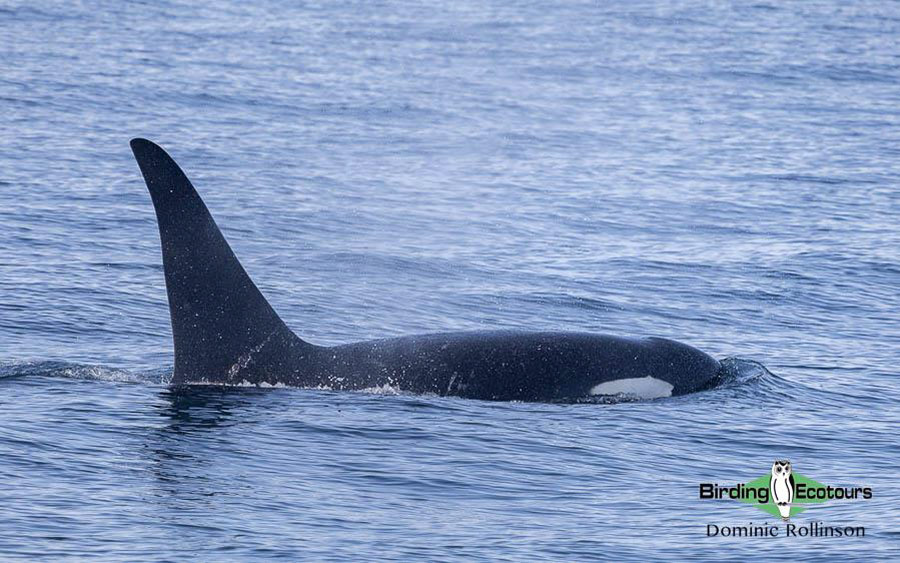
A small Killer Whale pod was seen during one of our Hokkaido boat cruises.
Detailed Report
Day 1, 19th February 2025. Arrival and afternoon birding around Kirishima
The whole group had arrived in Kirishima by around midday and so, after some time to unpack bags, we met up with John, our expert local guide and driver, and headed out into the forested hills near to town. Our aim was to try bump into Copper Pheasant, which is one of the trickier Japanese endemics to lay eyes on. Unfortunately, luck was not on our side this afternoon, however, we did get our first looks at common species such as Oriental Turtle Dove, Japanese Pygmy Woodpecker, Cinereous and Long-tailed Tits, Brown-eared Bulbul, White-cheeked Starling, Pale and Dusky Thrushes and Meadow Bunting. That evening we all enjoyed an excellent dinner and excitedly discussed the trip ahead.
Day 2, 20th February 2025. Morning birding around Kirishima and transfer to Izumi
After an early breakfast we made a quick stop at the Amori River below our hotel which added Eastern Spot-billed Duck, Black-faced Spoonbill, Little Ringed Plover, Common Kingfisher, Siberian Pipit and White and Grey Wagtails. We then headed back to the Kagoshima Prefectural Forest to have another crack at Copper Pheasant, which again proved elusive. The birding was, however, more productive than the previous afternoon and we added White-backed Woodpecker, Varied Tit, Red-flanked Bluetail, Daurian Redstart and an incredibly obliging Ryuku Minivet.
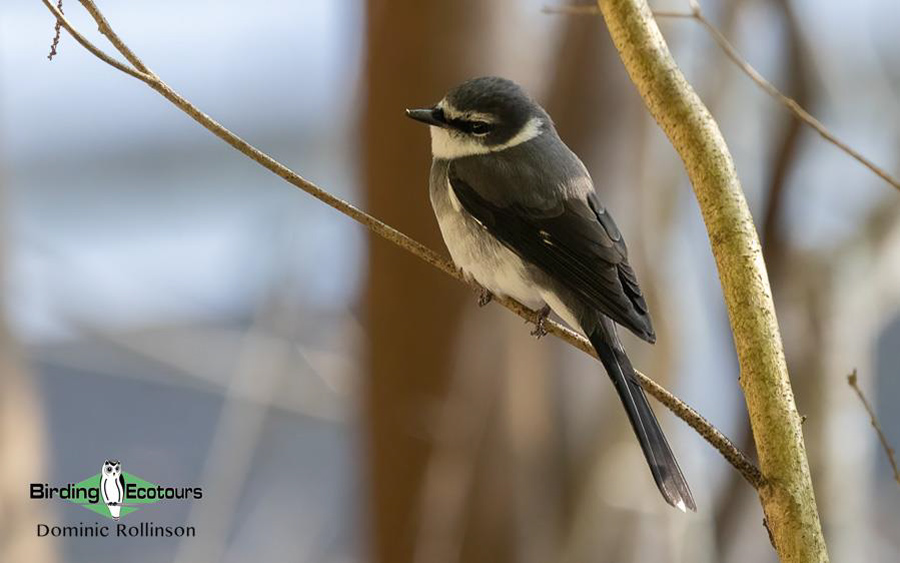
We couldn’t have asked for better looks at this cute Ryuku Minivet.
We did not linger in the forest and after a while decided to hit the road towards Izumi, with a few scheduled birding stops along the way. Saunders’s Gull would be our primary target along the drive. We stopped at the Kuma River estuary, which was at first a little quiet, with just Eurasian Wigeon, Little Grebe, Osprey and Bull-headed Shrike of interest here. After a quick bite to eat we decided to move around the corner and, as we arrived, we knew this was the spot to be, with large numbers of shorebirds and gulls around. The good numbers of gulls around all turned out to be Saunders’s Gulls, some even in full breeding attire, with most birds in non-breeding plumage. We spent a while here looking through the impressive numbers of water birds and managed to pick out Common Shelduck, Northern Pintail, Grey Plover, Common Greenshank, Dunlin, Great Crested and Black-necked Grebes, Eurasian and Black-faced Spoonbills and Grey Heron, while the surrounding fields held White-cheeked Starling, Blue Rock Thrush, White Wagtail and an impressive flock of 500+ Brambling.
We then made our way to Izumi with a quick stop on the Komenotsu River adding Black-tailed, Vega and Slaty-backed Gulls. We still had most of the afternoon at our disposal and so decided to make a start on our birding around Arasaki. As expected, the fields here were teeming with cranes and we enjoyed our first looks at the vast numbers of Hooded Cranes interspersed with smaller numbers of White-naped Cranes. While birding the crane fields we also added the likes of Eurasian Teal, Eastern Buzzard, Eurasian Skylark, Dusky Thrush, Rook, Red-throated and Siberian Pipits and Masked Bunting. We scoured the reedbeds for Chinese Penduline Tits, with a distant flock shooting by and only posing briefly, being the best we could do (for now). Other good birds seen in and around the reedbeds included Tufted Duck, Osprey, Black Kite, Bull-headed Shrike, Daurian Redstart, Eurasian Tree Sparrow and Meadow and Common Reed Buntings.
We ended the day enjoying feeding cranes in the glorious golden light, before calling it a day and heading to Izumi for the night.
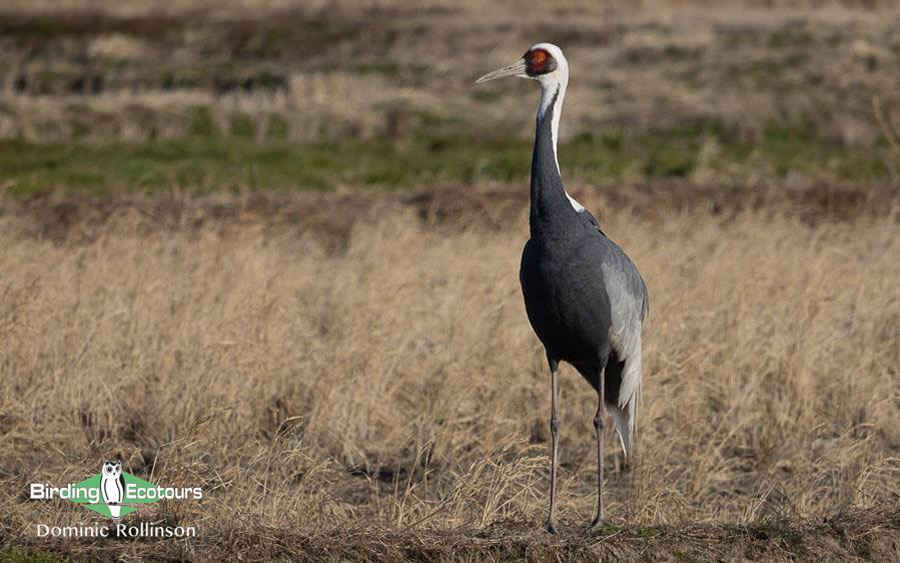
The striking White-naped Crane at Izumi Crane Centre.
Day 3, 21st February 2025. Kogawa Dam and Arasaki birding
We set off early to Kogawa Dam, just outside of Izumi, to look for a few waterfowl and mostly to bird the forests surrounding the dam. During our first scan of the large dam, we managed to pick out a couple pairs of Mandarin Ducks (proper wild birds), while the dam also held small numbers of Falcated, Tufted and Eastern Spot-billed Ducks, Mallard, Eurasian Teal and Common Pochard. We then focused on birding the surrounding forest, which was very quiet (and cold), but we eventually managed to eke out a few of our target birds, with the bird of the day being a pair of relatively confiding Copper Pheasants, which we were all very relieved to find. Other quality birds seen in the forest included Eurasian Sparrowhawk, White-backed, Japanese Pygmy and Japanese Green Woodpeckers, Eurasian Jay, Varied Tit, Red-flanked Bluetail and Daurian Redstart.
On our way back to Izumi (adding a flyby Eurasian Woodcock en route) we again scanned the Komenotsu River, which produced one of our target birds, Long-billed Plover, along with our first Warbling White-eyes of the trip. We then picked up our lunch at a convenience store (which would become a theme of the trip) and headed back to the Arasaki area.
Despite birding here the previous day, there were still new birds on offer, and we managed to find a few Common Cranes in amongst the thousands of Hooded and White-naped Cranes, as well as Daurian Jackdaw and Zitting Cisticola. A Japanese Weasel was a surprise sighting during our lunch stop. We then made a stop at the nearby Izumi Crane Centre, which had impressive densities of cranes and, from the sightings board, we learnt that there were around 12,000 cranes currently in the area. From the observation tower we further spotted Northern Lapwing, Common Snipe, Eurasian Spoonbill, Daurian Jackdaw, Carrion and Large-billed Crows and dozens of Black Kites.
It had been a long day of birding and so we decided to head back a bit earlier and en route John found us a small flock of Russet Sparrows, with Gadwall and Peregrine Falcon (impressive spot by Mary) being the final new birds of the day.
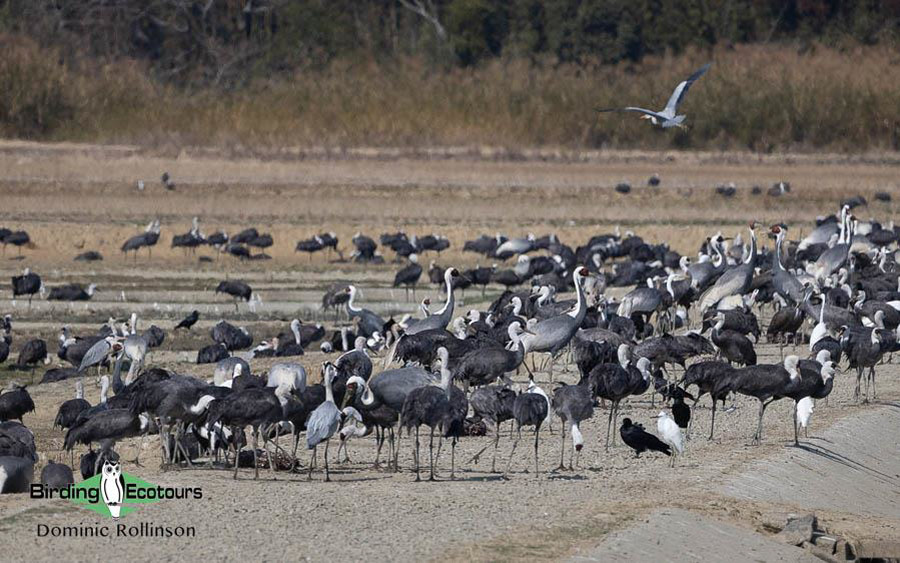
The assortment of cranes and other birds seen at the Izumi Crane Centre.
Day 4, 22nd February 2025. Izumi birding and transfer to Hyuga
We hadn’t yet given up on better views of Chinese Penduline Tit and decided to bird the Komenotsu River one final time, which proved a good decision as we had good looks at a small group of penduline tits and our first looks at Japanese Bush Warbler. Here, we also found a good-sized group of Falcated Ducks and Grant saw a Eurasian Sparrowhawk fly nearby.
We were still missing a few targets around Kogawa Dam and so decided to give it another go before we made our way to the east coast of Kyushu. This again proved a good decision as we found a few White-bellied Green Pigeons as well as a single Grey Bunting which showed very briefly for us but was unfortunately missed by most of the group.
We continued our way east and stopped in at Miike Crater Lark for our picnic lunch, which is a picturesque and tranquil spot, however, the birding was on the quiet side here as the wind had picked up. Some nice birds seen here included Grey Wagtail and Red-flanked Bluetail. As we left the lake, we enjoyed views of the impressive Mount Takachiho, an active volcano – one of the many found throughout Japan.
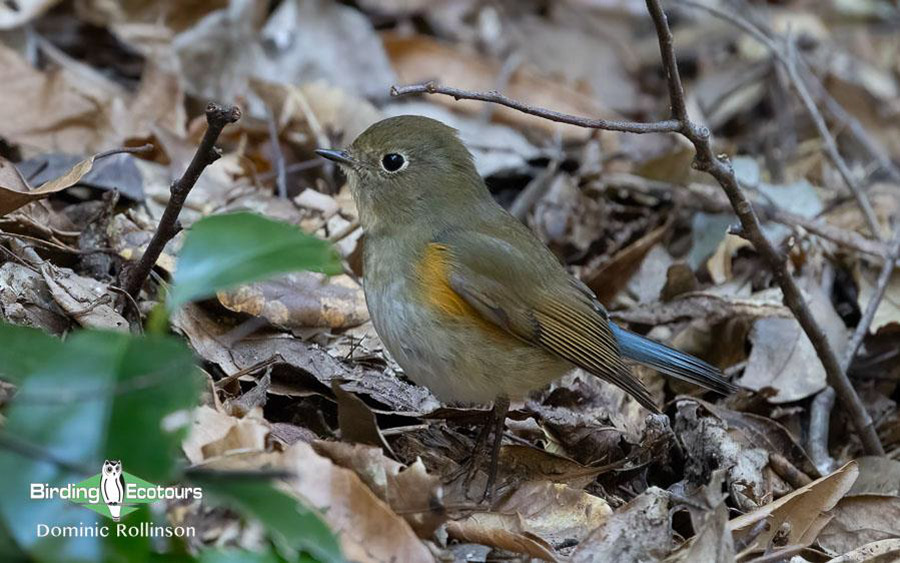
Red-flanked Bluetails were relatively common on Kyushu.
We had been following Japanese rare bird reports and had discovered a couple vagrant ducks were showing at nearby Kota Ponds. We arrived at the large pond, and it didn’t take long to find the Ferruginous Duck and then a single vagrant presumed Baer’s Pochard – which we were later informed was in fact a Ferruginous Duck x Baer’s Pochard hybrid, which explained the slightly brown crown. It was a bit disappointing that it was not considered a pure Baer’s Pochard, but it was still interesting to see the bird in question. There were lots of other waterfowl on the pond including Northern Shoveler, Eurasian Wigeon, Common Pochard, Tufted Duck and Smew which were good fun to work through.
It was then next onto the coast around Cape Hyuga where, after some diligent scanning, we managed to find a couple Japanese Murrelets which took some effort for us all to see (as they would keep disappearing on long feeding dives), but we eventually all had good looks. Here we also found Black-tailed and Vega Gulls, Japanese Cormorant, Pacific Reef Heron and a few of the introduced Red-billed Leiothrix in the nearby forest. We then headed to our accommodation for the night after what had been a long but productive day of birding.
Day 5, 23rd February 2025. Final Kyushu birding and flight to Tokyo
Today we had midday flights from Miyazaki to Tokyo, and the main island of Honshu, and decided to have another birding session en route at Kota Ponds, which had been so productive the previous day. This morning we mostly concentrated on the surrounding fields, rather than the waterfowl, and got lucky with an assortment of buntings including Chestnut-eared, Yellow-throated, Rustic and Masked Buntings. A quick scan of the pond revealed a single male Baikal Teal.
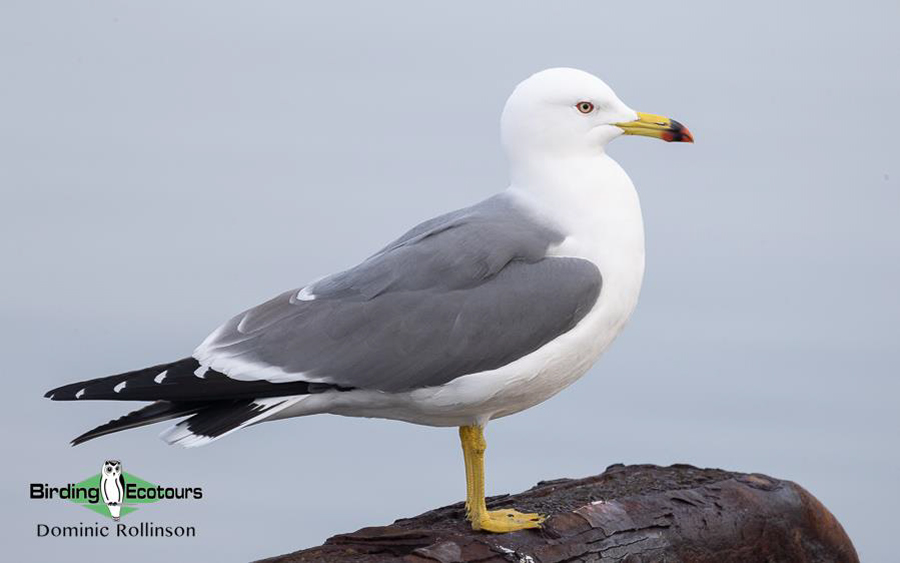
We encountered nine species of gulls on this tour including the attractive Black-tailed Gull.
We then caught our flight to Haneda Airport, Tokyo and, after sorting out the new van, we were on our way to the Narita area for the night. En route, we stopped at Lake Inbanuma which proved a great stop indeed. Here we found Falcated Duck, Common Pochard, Smew, Common Snipe, Black-headed Gull, Great Crested Grebe, Eastern Marsh Harrier and Brown-headed Thrush. The undoubted highlight of the afternoon (and perhaps of the trip) was a flyby of an enormous flock of Baikal Teal,which did a couple of whirls around, before they headed into nearby fields to feed for the night. It’s always difficult to estimate the size of a huge number like this but the flock certainly numbered into the tens of thousands! A flushed Green Pheasant was a good cap to the day, but we hoped to improve our views.
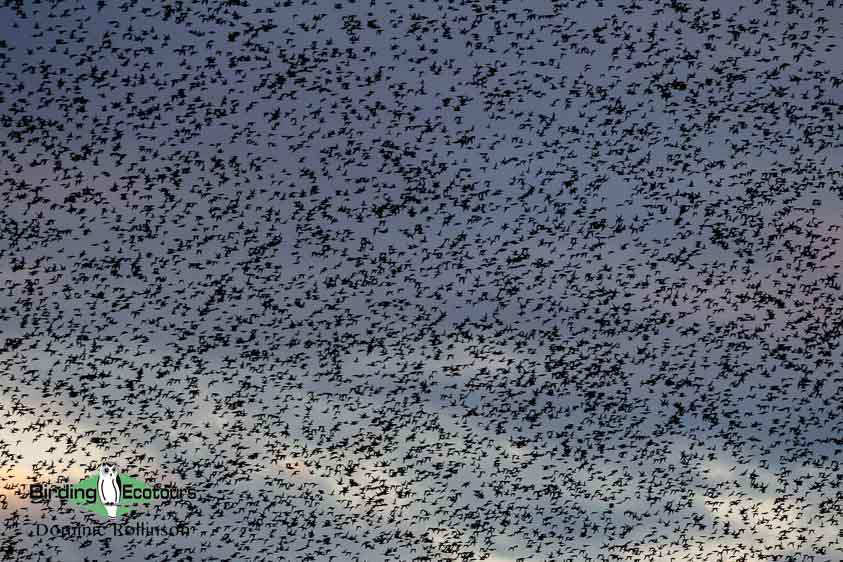
Part of the massive Baikal Teal flock seen at Lake Inbanuma.
Day 6, 24th February 2025. Ukishima Marsh and transfer to Karuizawa
This morning we birded the Ukishima Marsh area in the hope of finding Marsh Grassbird andOchre-rumped Bunting. We arrived at the vast wetland and reedbeds and went for a pleasant walk along the edge of the marsh. We heard the contact call of Marsh Grassbird but, despite our best efforts, we could not lay eyes on the bird and had to settle for a ‘heard only’ tick. We did not have any luck with the Ochre-rumped Buntings either but did manage to find Black-winged Stilt, Common Snipe, Osprey, Eastern Marsh Harrier and Meadow, Common Reed, Rustic and Masked Buntings.
Our next stop was some fields where John had previously encountered Tundra Swans and, right on cue, the swans appeared, and we happily moved onto our next stop.
It was then time to target Mountain Hawk-Eagle, and we decided to have our lunch while we waited at the stakeout, in a mountainous area, near to Karuizawa. Mary spotted a dot way up in the trees, which I originally dismissed as Eastern Buzzard, but on John telling us he’d never seen buzzards here, we had another look and realized this was in fact our quarry – a Mountain Hawk-Eagle! While waiting for the hawk-eagles we also had our best looks yet of Varied Tits. A stop at a bridge nearby produced the goods when Seth spotted a pair of Brown Dippers which flew right by us, with Japanese, Grey and White Wagtails all showing well here too.
We then moved closer to Karuizawa and took a road through some forested hills where we hoped to find Japanese Accentor. We kept getting brief glimpses of them as they flew across the road until a single bird showed briefly for some of the group on a road embankment, however, it was definitely a ‘better-views-desired’ sighting. In these forests we also had Eurasian Jay and Coal, Varied, Willow, Cinereous and Long-tailed Tits.
Day 7, 25th February 2025. Snow monkeys and Karuizawa birding
The snow monkeys of Jigokudani hot springs were on the agenda this morning. Jigokudani is a hot spring, outside of the city of Nagani, and it’s here where Japanese Macaques were first noticed bathing in an onsen in the area. After realizing this, the area was closed off for the monkeys and during the winter months they utilize the hot spring, which makes for some lovely scenes of them feeding in the snow and then warming up in the hot spring. It was roughly a 90-minute drive from Karuizawa and then about a 30-minute walk through an enchanting forest with lots of snow around (with Goldcrests seen along the walk). We arrived here at opening time and could essentially enjoy the walk on our own, before the large groups of tourists arrived. We spent about 45 minutes with the Japanese Macaques, watching them as they fed and played with each other. Just as we were about to leave, a friendly Alpine Accentor showed itself and allowed views down to a meter – this is how accentors should behave.
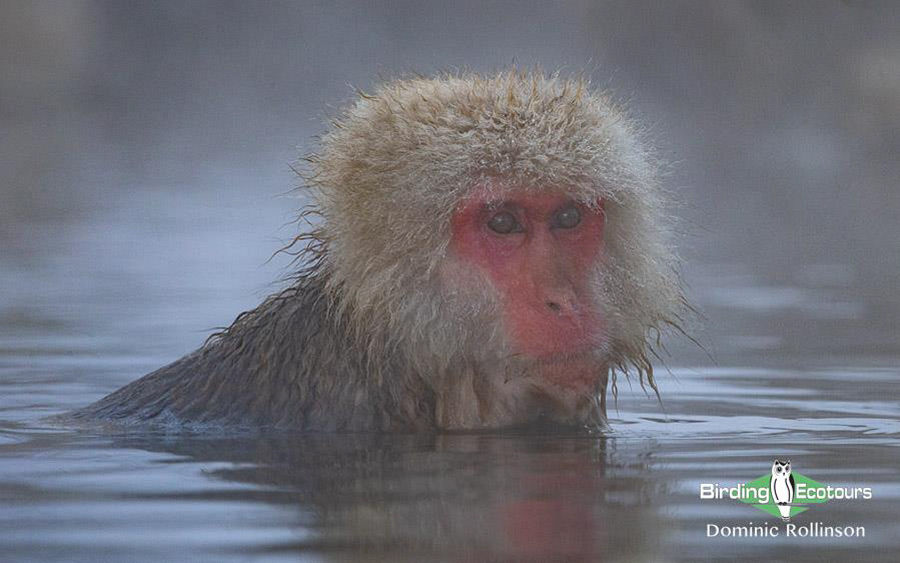
We enjoyed watching Japanese Macaques bathing in the hot springs at Jigokudani.
We then made our way back to Karuizawa and birded the surrounding forests, which was a little on the slow side, but with patience we notched up Great Spotted Woodpecker, Willow Tit, Eurasian Nuthatch and Eurasian Wren.
We finished the day birding some agricultural areas outside of Karuizawa in the hope of bumping into Japanese Grosbeak, however, we had to settle for Dusky Thrush, Oriental Greenfinch and Meadow and Rustic Buntings.
Day 8, 26th February 2025. Karuizawa birding and afternoon flight to Hokkaido
We decided that we needed to improve our views of Green Pheasant and so went to some nearby fields at first light and saw at least six male Green Pheasants which posed nicely for us, although they always kept a safe distance from us! After breakfast we made another attempt at seeing Japanese Grosbeak and this time, we were successful with good views of a pair of these enigmatic finches. Also in the area, Grant had us turn the vehicle around for a large mammal which turned out to be a Japanese Serow – a strange-looking and taxonomically confusing goat-antelope.
The rest of the day was spent traveling back to Tokyo to catch an afternoon flight to Kushiro on Hokkaido, where we would be based for the next few days.
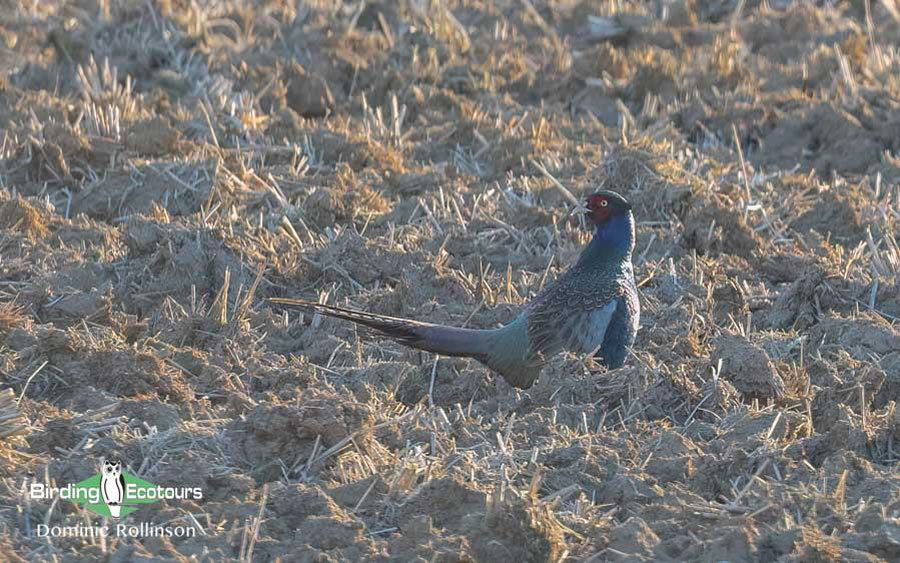
It took some time, but we eventually had good looks at the Japanese endemic Green Pheasant.
Day 9, 27th February 2025. Hokkaido birding
A very early start was in order today as we wanted to be in place to watch Red-crowned Cranes at sunrise in the Setsuri River – a rather beautiful scene! We arrived at around sunrise, with the cranes obliging and we enjoyed watching and listening to them as they slowly started heading out to their feeding grounds for the day. From Otowa Bridge we also saw Common Merganser, Crested Kingfisher, Japanese Wagtail, a very distant Northern Shrike and our first (distant) Steller’s Sea Eagles. We also spotted our first of many Sika Deer for the day, which were to become a constant feature of the open landscape of Hokkaido.
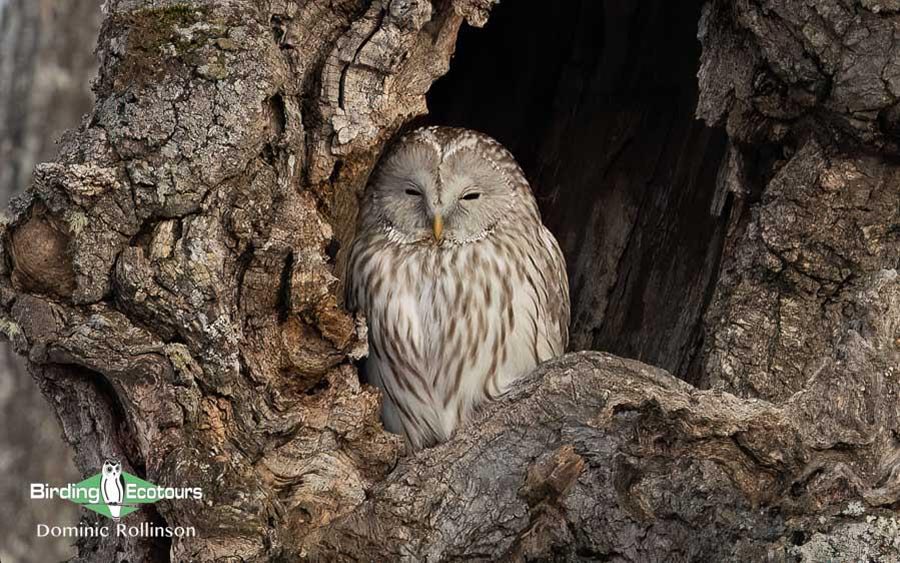
Ural Owl was seen at its usual roost site.
We then moved around the corner to a Ural Owl roost, with the bird showing well for us in the early morning light and here we found a few good bird parties in which we saw Great Spotted Woodpecker, Eurasian Nuthatch, Eurasian Treecreeper, Eurasian Siskin and Willow, Marsh, Cinereous, Coal and Long-tailed Tits (of the incredibly cute white-headed form; known locally as snow fairies).
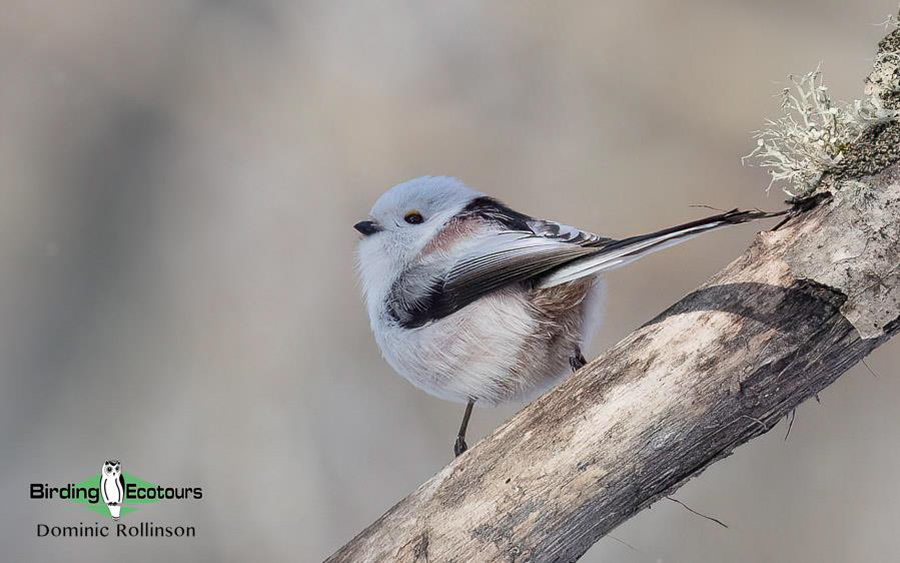
The white-headed form of Long-tailed Tit are known as snow fairies on Hokkaido.
We then picked up breakfast in town and sat and ate at a feeding site for Red-crowned Cranes, where we could get very close to the cranes and watch them in the morning light. The cranes were completely unphased by our presence and, at another nearby site, Vicky spotted a single White-naped Crane in amongst them, which also showed well for us. At the crane site, we managed to find Siberian Long-tailed Rosefinch which had eluded us until now.
From Tsurui, we continued our way north and stopped in at Lake Kussharo. As we got out the van, we noticed lots of feeding passerines in the nearby woods and were thrilled to find good numbers of Dusky Thrush, Hawfinch, Brambling, Japanese Grosbeak, Eurasian Siskin, Eurasian Treecreeper and John spotted a pair of Grey-headed Woodpeckers (a tough bird in Japan). We ate our lunch while watching the large group of friendly Whooper Swans nearby.
We then made a quick stop at Mount Io, an active volcano that last erupted in 1936, in the hopes of finding Asian Rosy Finch, but had to settle with viewing the impressive sulfur deposits (from when the volcano erupted liquid sulfur) and walking in amongst the steam vents.
It had been a long day out and we were all keen to spend some time enjoying the onsen and so we again made our way north, with a quick stop to add a pair of showy Black Woodpeckers en route. As a final bonus for the day, a confiding Red Fox showed for us in the beautiful afternoon light, which made for a lovely scene.
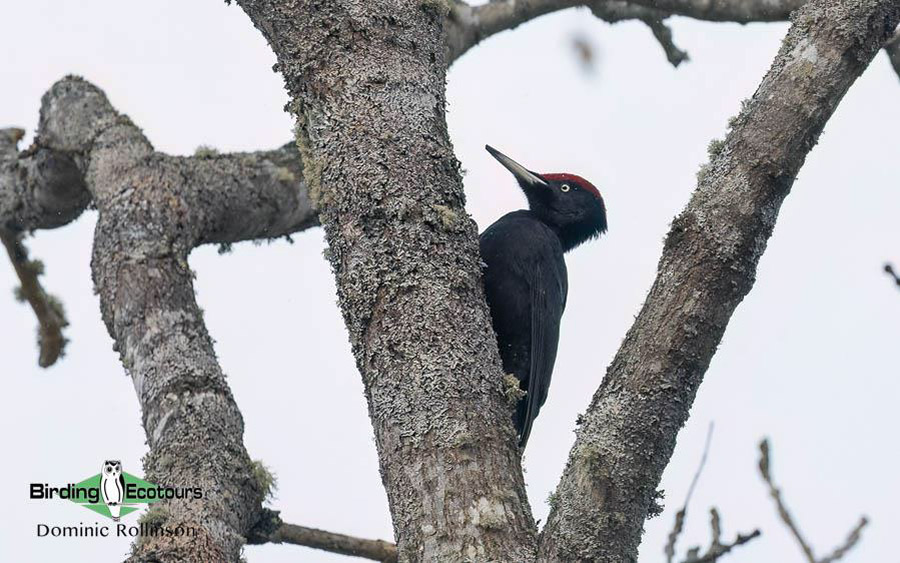
The striking Black Woodpecker was seen well.
That evening we enjoyed a traditional Japanese meal, of many tasty and exotic courses, before some of us started the nighttime vigil waiting for Blakiston’s Fish Owl. The appeal of staying at this particular onsen has much to do with the visiting Blakiston’s Fish Owls which come to take fish from a pond next to the river in the evening. The warm and cozy onsen lounge is right next to where the owls come in and so, although it can be a very long wait, it can at least be done in comfort. We had devised a plan to alert the group to the owl’s presence and some of us waited up the entire night, but unfortunately it was a no-show tonight and we’d have to hope for the best the next night (we book two nights here for this very reason!). A quick visit from a Sable (a small mustelid) was about the best we could manage tonight.
Day 10, 28th February 2025. Shiretoko Peninsula boat trip and birding Notsuke Peninsula
After a long night for some of us, we were greeted by a Solitary Snipe feeding in the river just after breakfast. We then loaded up into the van and made our way to the Shiretoko Peninsula where we would be joining a boat cruise which turned out to be one of the many highlights of the trip.
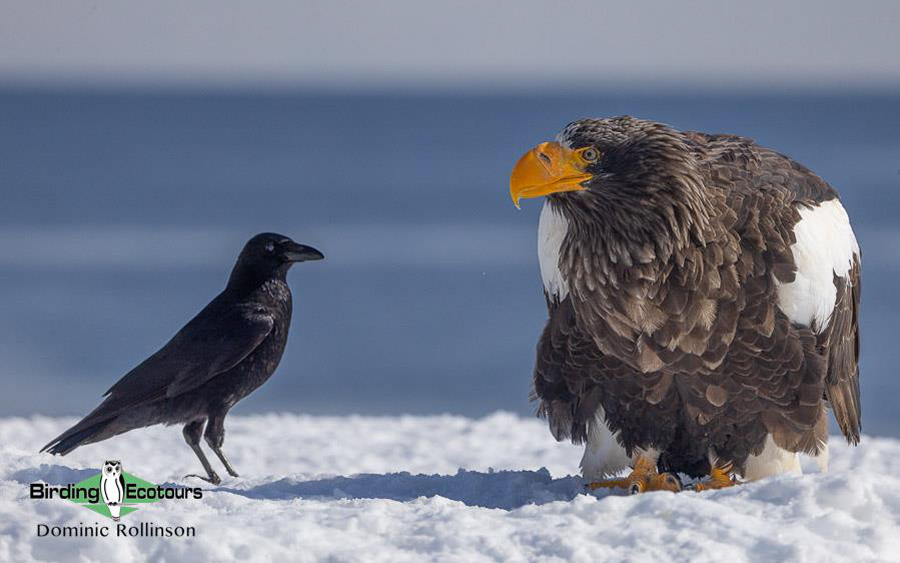
A Carrion Crow helps put the massive size of Steller’s Sea Eagle into perspective here!
The boat left from Rausu port, and it wasn’t long after we left the harbor that we found a pod of around five or six Killer Whales (Orca). We enjoyed watching these massive predators for a while, which included a couple of large males with tall dorsal fins. One of the main reasons for doing this boat trip was to witness the spectacle of hundreds of wintering sea eagles which are attracted to the many fishing (and tourist) vessels in the area, looking for fish scraps and handouts. There was no sea ice around today, however, we still had amazing, point-blank views of both Steller’s and White-tailed Sea Eagles swooping down to take fish and sitting on the piles of snow and ice. We estimated over 200 sea eagles, coming in to enjoy the feast, of a roughly 50:50 ratio of Steller’s Sea Eagles to White-tailed Eagles. Gulls were also in high attendance, and we enjoyed working through the flocks which were comprised of Slaty-backed, Glaucous-winged, Glaucous, Common (Kamchatka subspecies) and Black-headed Gulls. Seth did well to pick out a juvenile Iceland (Thayer’s) Gull, a rarity for the area. Other interesting birds seen out on the water included Red-breasted Merganser, Spectacled Guillemot and Pelagic Cormorant.
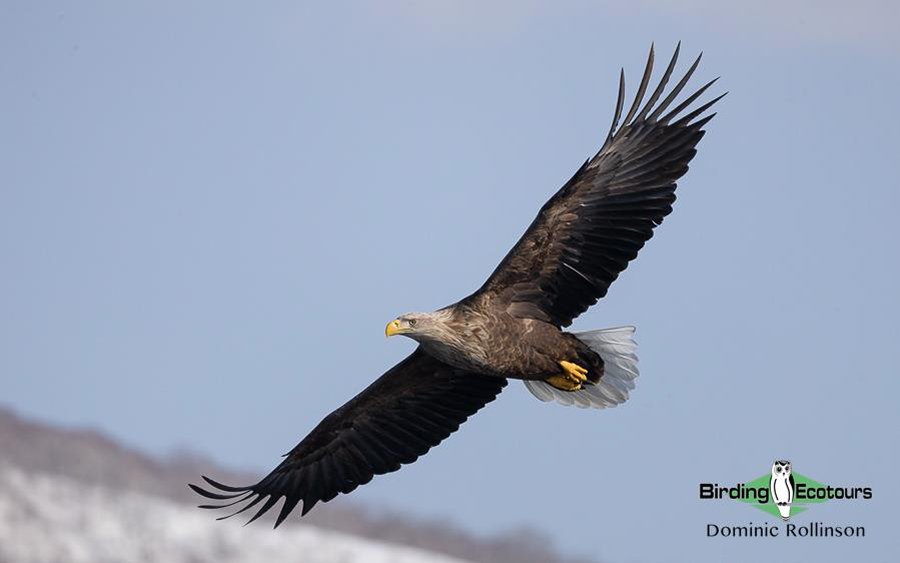
White-tailed Eagles were numerous on our Hokkaido boat trips.
Once back on dry land, we made our way south along the coast and this time concentrated on sea ducks, of which there were many around. Constant scanning of the coastline paid off as we soon found the likes of Harlequin Duck, Stejneger’s and Black Scoters, Common Goldeneye and Red-breasted Merganser, along with Red-throated Diver and more Spectacled Guillemots. A quick stop at Shibetsu Port proved productive as we found a large group of waterfowl which comprised of Eurasian Wigeon, Tufted Duck, Greater Scaup, Common Goldeneye and Red-breasted Merganser. We were also excited to spot a group of Northern Fur Seals along the coastline.
We then ate our lunch at Cape Nosappu, where we again looked unsuccessfully for Asian Rosy Finch, however, a scan out to sea revealed Stejneger’s and Black Scoters, Long-tailed Duck, Red-necked Grebe, Black-throated Loon and Pelagic Cormorant. On our way back along the peninsula we spotted some geese which turned out to be Tundra Bean Geese, with large numbers of Whooper Swans seen here too. After another enjoyable day out, we made our way back to the onsen and took some time off in the late afternoon before the next fish owl vigil!
It was another long wait and then, finally, at 04h30 am, a single massive Blakiston’s Fish Owl pitched up and helped itself to a fish and hung around long enough for most of the group to lay eyes on the world’s largest owl species! We then all went back to sleep for a couple of hours, exhilarated and pleased!
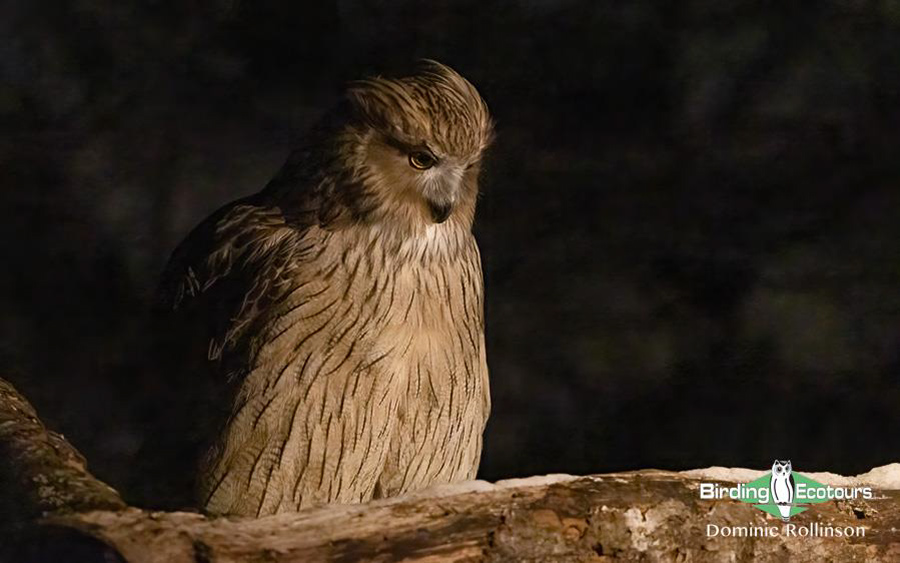
After a very long two nights, Blakiston’s Fish Owl finally showed for us at the onsen.
Day 11, 1st March 2025. Shiretoko Peninsula boat trip and birding
We had a more civilized start this morning and enjoyed breakfast at the onsen, before we packed the van and made our way southeast towards Nemuro Peninsula, where we were based for the night.
We of course made a few birding stops en route, and stopped in at the Hashirikotan spit, where Asian Rosy Finch was again high on the agenda. Luck was again not on our side and, despite a concerted effort, we could not find the finches. We did, however, find a large group of Brant Geese,along with more Stejneger’s and Black Scoters and a good-sized flock of Snow Buntings, which flew by all too briefly.
Next up was another boat trip, this time from Habomai harbor, where we hoped to find a few more alcid species. Unfortunately, there weren’t large numbers of alcids around today and we had to work for our birds but did manage to find Pigeon Guillemot (of both columba and snowi subspecies) and more Spectacled Guillemots. We also had repeat views of Harlequin Duck, Greater Scaup, Long-tailed Duck, Common Merganser and Red-necked Grebe, while Pacific Diver was a new trip bird.
After our boat trip, we picked up our lunch and made our way to the tip of the peninsula (this time by road) and set up our scopes to look for Rock Sandpiper at the usual stakeout at Cape Nosappu. The sandpipers would not show for us this afternoon, but we did manage to find Falcated Duck, Greater Scaup, Black Scoter, Harlequin Duck and an assortment of gulls. A heads-up from a visiting birder had us rushing around the corner where we had good looks at a single, range-restricted and rare Red-faced Cormorant, which was roosting in amongst the numerous Pelagic Cormorants here. A single Sea Otter was another highlight here and we had good but distant looks at an animal relaxing on its back while floating in the water. We then decided to have one more scan for Rock Sandpiper (again no luck) before calling it a day.
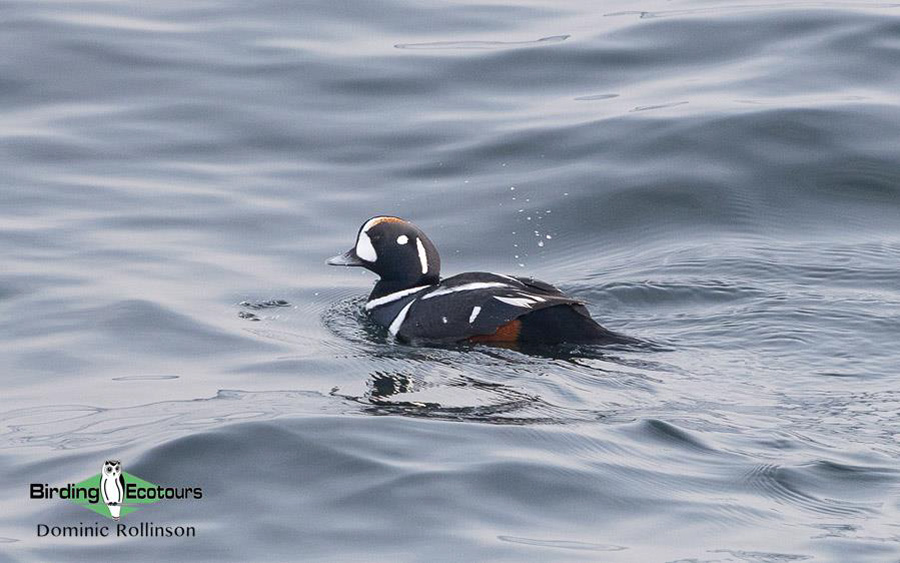
We encountered many duck species on this tour, none prettier than the male Harlequin Duck.
Day 12, 2nd March 2025. Shiretoko Peninsula birding and flight back to Tokyo
It was back to Cape Nosappu this morning as we were determined to find the Rock Sandpipers and, upon our arrival at the stake-out, we were told by some other birders that the sandpipers were around, and managed good but distant looks at these incredibly range-restricted sandpipers.
On our way back to Kushiro Airport (for our flights back to Tokyo) we popped in at a few spots, in a last-ditch effort to find Asian Rosy Finches, which were still not playing along and we eventually had to accept defeat with this species.
Upon arrival back in Tokyo, we caught the train to the ferry terminal and eventually boarded the ship in the late evening for our ferry trip to the Izu Islands.
Day 13, 3rd March 2025. Ferry trip to the Izu Islands
We awoke to rough seas (although the ferry handled the seas very well) and strong winds and decided that the original plan of getting off at Miyake Jima for the morning, to look for the island’s specials, was not going to work out. We thus had to revert to plan B, which would be to remain on the ferry and enjoy the pelagic birding. It was disappointing to miss the Miyake Jima specials (such as Izu Robin, Izu Thrush, Owston’s Tit and Japanese Wood Pigeon), however, with the gale force winds the sea birding was about as good as it gets, and we spent an enjoyable day finding some high-quality pelagic species.
Streaked Shearwater was the most common species out at sea, and they accompanied us throughout the day and numbered into the thousands. We encountered all three species of North Pacific albatrosses today, with the most common being Black-footed Albatross and smaller numbers of Short-tailed and Laysan Albatrosses. We briefly visited Hachijo Jima, however, our time was too limited to even begin the search for any of the Izu Islands specials, but we did see Pacific Golden Plover and Blue Rock Thrush here. On our way back to Tokyo Bay, we encountered good numbers of Providence Petrel and many Tristram’s Storm Petrel while we also saw unexpected species such as Red Phalarope and Leach’s Storm Petrel. Throughout the day we also had brief looks at Common Bottlenose Dolphin and a single Humpback Whale.
We eventually made it back to our Tokyo hotel later that evening, after what had been a very long but incredibly productive day at sea, with some dream pelagic birds in the bag!
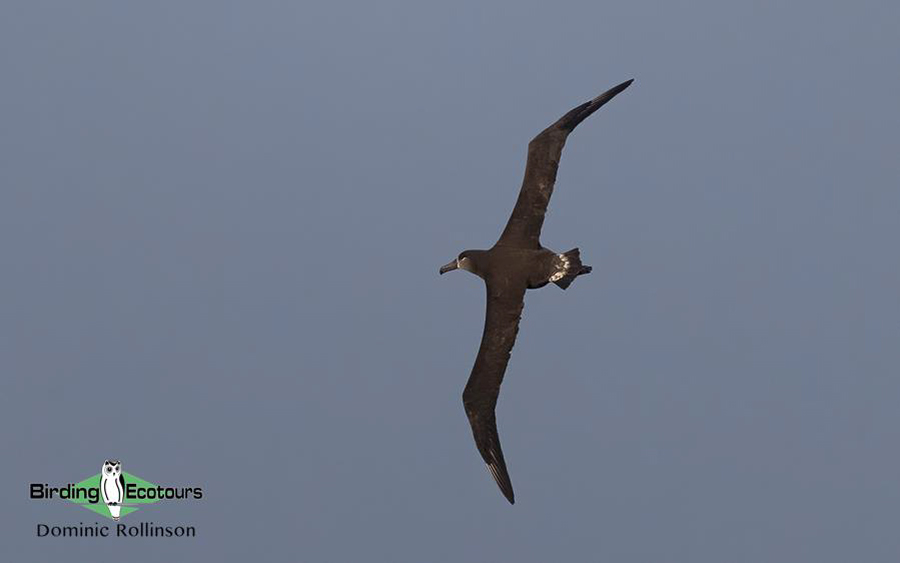
Black-footed Albatross was one of three albatross species seen on the Izu Islands ferry crossing.
Day 14, 4th March 2025. Departure from Tokyo
We didn’t have any birding scheduled for this morning and the tour ended with breakfast in the hotel. Everybody had at least one more night in Tokyo and some of us enjoyed a city tour today, or some final birding around Tokyo. A big thank you to John for his expert driving and knowledge of Japan and its birds, and thank you to all of the tour participants for your perseverance, enthusiasm and humor which all helped make the tour the success it was.
Bird List – Following IOC (Version 15.1/February 2025)
Birds ‘heard only’ are marked with (H) after the common name, all other species were seen.
The following notation after species names is used to show conservation status following BirdLife International: EN = Endangered, VU = Vulnerable.
| Common Name | Scientific Name |
| Ducks, Geese, Swans (Anatidae) | |
| Brant Goose | Branta bernicla |
| Tundra Bean Goose | Anser serrirostris |
| Tundra Swan | Cygnus columbianus |
| Whooper Swan | Cygnus cygnus |
| Common Shelduck | Tadorna tadorna |
| Mandarin Duck | Aix galericulata |
| Baikal Teal | Sibirionetta formosa |
| Northern Shoveler | Spatula clypeata |
| Gadwall | Mareca strepera |
| Falcated Duck | Mareca falcata |
| Eurasian Wigeon | Mareca penelope |
| Eastern Spot-billed Duck | Anas zonorhyncha |
| Mallard | Anas platyrhynchos |
| Northern Pintail | Anas acuta |
| Eurasian Teal | Anas crecca |
| Common Pochard – VU | Aythya ferina |
| Ferruginous Duck | Aythya nyroca |
| Tufted Duck | Aythya fuligula |
| Greater Scaup | Aythya marila |
| Harlequin Duck | Histrionicus histrionicus |
| Stejneger’s Scoter | Melanitta stejnegeri |
| Black Scoter | Melanitta americana |
| Long-tailed Duck – VU | Clangula hyemalis |
| Common Goldeneye | Bucephala clangula |
| Smew | Mergellus albellus |
| Common Merganser | Mergus merganser |
| Red-breasted Merganser | Mergus serrator |
| Pheasants & Allies (Phasianidae) | |
| Copper Pheasant (Endemic) | Syrmaticus soemmerringii |
| Green Pheasant (Endemic) | Phasianus versicolor |
| Pigeons, Doves (Columbidae) | |
| Rock Dove | Columba livia |
| Oriental Turtle Dove | Streptopelia orientalis |
| White-bellied Green Pigeon | Treron sieboldii |
| Rails, Crakes & Coots (Rallidae) | |
| Common Moorhen | Gallinula chloropus |
| Eurasian Coot | Fulica atra |
| Cranes (Gruidae) | |
| White-naped Crane – VU | Antigone vipio |
| Red-crowned Crane – VU | Grus japonensis |
| Common Crane | Grus grus |
| Hooded Crane – VU | Grus monacha |
| Grebes (Podicipedidae) | |
| Little Grebe | Tachybaptus ruficollis |
| Red-necked Grebe | Podiceps grisegena |
| Great Crested Grebe | Podiceps cristatus |
| Black-necked Grebe | Podiceps nigricollis |
| Stilts, Avocets (Recurvirostridae) | |
| Black-winged Stilt | Himantopus himantopus |
| Plovers (Charadriidae) | |
| Grey Plover – VU | Pluvialis squatarola |
| Pacific Golden Plover | Pluvialis fulva |
| Little Ringed Plover | Charadrius dubius |
| Long-billed Plover | Charadrius placidus |
| Northern Lapwing | Vanellus vanellus |
| Sandpipers, Snipes (Scolopacidae) | |
| Eurasian Woodcock | Scolopax rusticola |
| Solitary Snipe | Gallinago solitaria |
| Common Snipe | Gallinago gallinago |
| Red Phalarope | Phalaropus fulicarius |
| Common Sandpiper | Actitis hypoleucos |
| Green Sandpiper | Tringa ochropus |
| Common Greenshank | Tringa nebularia |
| Dunlin | Calidris alpina |
| Rock Sandpiper | Calidris ptilocnemis |
| Gulls, Terns, Skimmers (Laridae) | |
| Saunders’s Gull – VU | Saundersilarus saundersi |
| Black-headed Gull | Chroicocephalus ridibundus |
| Black-tailed Gull | Larus crassirostris |
| Common Gull | Larus canus |
| Iceland Gull | Larus glaucoides |
| Vega Gull | Larus vegae |
| Glaucous Gull | Larus hyperboreus |
| Glaucous-winged Gull | Larus glaucescens |
| Slaty-backed Gull | Larus schistisagus |
| Auks (Alcidae) | |
| Spectacled Guillemot | Cepphus carbo |
| Pigeon Guillemot | Cepphus columba |
| Japanese Murrelet – VU | Synthliboramphus wumizusume |
| Loons (Gaviidae) | |
| Red-throated Loon | Gavia stellata |
| Black-throated Loon | Gavia arctica |
| Pacific Loon | Gavia pacifica |
| Albatrosses (Diomedeidae) | |
| Laysan Albatross | Phoebastria immutabilis |
| Black-footed Albatross | Phoebastria nigripes |
| Short-tailed Albatross – VU | Phoebastria albatrus |
| Northern Storm Petrels (Hydrobatidae) | |
| Leach’s Storm Petrel – VU | Hydrobates leucorhous |
| Tristram’s Storm Petrel | Hydrobates tristrami |
| Petrels, Shearwaters, Diving Petrels (Procellariidae) | |
| Providence Petrel | Pterodroma solandri |
| Streaked Shearwater | Calonectris leucomelas |
| Cormorants, Shags (Phalacrocoracidae | |
| Red-faced Cormorant | Urile urile |
| Pelagic Cormorant | Urile pelagicus |
| Japanese Cormorant | Phalacrocorax capillatus |
| Great Cormorant | Phalacrocorax carbo |
| Ibises, Spoonbills (Threskiornithidae) | |
| Eurasian Spoonbill | Platalea leucorodia |
| Black-faced Spoonbill – EN | Platalea minor |
| Herons, Bitterns (Ardeidae) | |
| Pacific Reef Heron | Egretta sacra |
| Little Egret | Egretta garzetta |
| Great Egret | Ardea alba |
| Grey Heron | Ardea cinerea |
| Ospreys (Pandionidae) | |
| Osprey | Pandion haliaetus |
| Kites, Hawks, Eagles (Accipitridae) | |
| Mountain Hawk-Eagle | Nisaetus nipalensis |
| Eurasian Sparrowhawk | Accipiter nisus |
| Eastern Marsh Harrier | Circus spilonotus |
| Black Kite | Milvus migrans |
| Steller’s Sea Eagle – VU | Haliaeetus pelagicus |
| White-tailed Eagle | Haliaeetus albicilla |
| Eastern Buzzard | Buteo japonicus |
| Owls (Strigidae) | |
| Blakiston’s Fish Owl – EN | Ketupa blakistoni |
| Ural Owl | Strix uralensis |
| Kingfishers (Alcedinidae) | |
| Common Kingfisher | Alcedo atthis |
| Crested Kingfisher | Megaceryle lugubris |
| Woodpeckers (Picidae) | |
| Japanese Pygmy Woodpecker | Yungipicus kizuki |
| Great Spotted Woodpecker | Dendrocopos major |
| White-backed Woodpecker | Dendrocopos leucotos |
| Black Woodpecker | Dryocopus martius |
| Japanese Green Woodpecker (Endemic) | Picus awokera |
| Grey-headed Woodpecker | Picus canus |
| Caracaras, Falcons (Falconidae) | |
| Common Kestrel | Falco tinnunculus |
| Peregrine Falcon | Falco peregrinus |
| Cuckooshrikes (Campephagidae) | |
| Ryukyu Minivet (Endemic) | Pericrocotus tegimae |
| Shrikes (Laniidae) | |
| Northern Shrike | Lanius borealis |
| Bull-headed Shrike | Lanius bucephalus |
| Crows, Jays (Corvidae) | |
| Eurasian Jay | Garrulus glandarius |
| Daurian Jackdaw | Coloeus dauuricus |
| Rook | Corvus frugilegus |
| Carrion Crow | Corvus corone |
| Large-billed Crow | Corvus macrorhynchos |
| Tits, Chickadees (Paridae) | |
| Coal Tit | Periparus ater |
| Varied Tit | Sittiparus varius |
| Marsh Tit | Poecile palustris |
| Willow Tit | Poecile montanus |
| Cinereous Tit | Parus cinereus |
| Penduline Tits (Remizidae) | |
| Chinese Penduline Tit | Remiz consobrinus |
| Larks (Alaudidae) | |
| Eurasian Skylark | Alauda arvensis |
| Bulbuls (Pycnonotidae) | |
| Brown-eared Bulbul | Hypsipetes amaurotis |
| Swallows, Martins (Hirundinidae) | |
| Barn Swallow | Hirundo rustica |
| Cettia Bush Warblers & Allies (Cettiidae) | |
| Japanese Bush Warbler | Horornis diphone |
| Bushtits (Aegithalidae) | |
| Long-tailed Tit | Aegithalos caudatus |
| Grassbirds & Allies (Locustellidae) | |
| Marsh Grassbird | Helopsaltes pryeri |
| Cisticolas & Allies (Cisticolidae) | |
| Zitting Cisticola | Cisticola juncidis |
| White-eyes (Zosteropidae) | |
| Warbling White-eye | Zosterops japonicus |
| Laughingthrushes & Allies (Leiothrichidae) | |
| Red-billed Leiothrix | Leiothrix lutea |
| Goldcrests, Kinglets (Regulidae) | |
| Goldcrest | Regulus regulus |
| Wrens (Troglodytidae) | |
| Eurasian Wren | Troglodytes troglodytes |
| Nuthatches (Sittidae) | |
| Eurasian Nuthatch | Sitta europaea |
| Treecreepers (Certhiidae) | |
| Eurasian Treecreeper | Certhia familiaris |
| Starlings, Rhabdornises (Sturnidae) | |
| White-cheeked Starling | Spodiopsar cineraceus |
| Thrushes (Turdidae) | |
| Pale Thrush | Turdus pallidus |
| Brown-headed Thrush | Turdus chrysolaus |
| Dusky Thrush | Turdus eunomus |
| Chats, Old World Flycatchers (Muscicapidae) | |
| Red-flanked Bluetail | Tarsiger cyanurus |
| Daurian Redstart | Phoenicurus auroreus |
| Blue Rock Thrush | Monticola solitarius |
| Dippers (Cinclidae) | |
| Brown Dipper | Cinclus pallasii |
| Old World Sparrows, Snowfinches (Passeridae) | |
| Russet Sparrow | Passer cinnamomeus |
| Eurasian Tree Sparrow | Passer montanus |
| Accentors (Prunellidae) | |
| Alpine Accentor | Prunella collaris |
| Japanese Accentor | Prunella rubida |
| Wagtails, Pipits (Motacillidae) | |
| Grey Wagtail | Motacilla cinerea |
| White Wagtail | Motacilla alba |
| Japanese Wagtail | Motacilla grandis |
| Red-throated Pipit | Anthus cervinus |
| Siberian Pipit | Anthus japonicus |
| Finches, Euphonias (Fringillidae) | |
| Brambling | Fringilla montifringilla |
| Hawfinch | Coccothraustes coccothraustes |
| Japanese Grosbeak | Eophona personata |
| Siberian Long-tailed Rosefinch | Carpodacus sibiricus |
| Oriental Greenfinch | Chloris sinica |
| Eurasian Siskin | Spinus spinus |
| Longspurs, Snow Buntings (Calcariidae) | |
| Snow Bunting | Plectrophenax nivalis |
| Buntings (Emberizidae) | |
| Meadow Bunting | Emberiza cioides |
| Chestnut-eared Bunting | Emberiza fucata |
| Rustic Bunting – VU | Emberiza rustica |
| Yellow-throated Bunting | Emberiza elegans |
| Masked Bunting | Emberiza personata |
| Grey Bunting | Emberiza variabilis |
| Common Reed Bunting | Emberiza schoeniclus |
| Total seen | 166 |
| Total heard only | 1 |
| Total recorded | 167 |
Mammal List – Following Mammalwatching.com (November 2024)
The following notation after species names is used to show conservation status following IUCN Red List: EN = Endangered, VU = Vulnerable.
| Common Name | Scientific Name |
| Old World Monkeys (Cercopithecidae) | |
| Japanese Macaque (Endemic) | Macaca fuscata |
| Squirrels (Sciuridae) | |
| Eurasian Red Squirrel | Sciurus vulgaris |
| Mustelids (Mustelidae) | |
| Sable | Martes zibellina |
| Sea Otter – EN | Enhydra lutris |
| Japanese Weasel | Mustela itatsi |
| Eared Seals (Otariidae) | |
| Northern Fur Seal – VU | Callorhinus ursinus |
| Earless Seals (Phocidae) | |
| Harbor Seal | Phoca vitulina |
| Canids (Canidae) | |
| Red Fox | Vulpes vulpes |
| Bovids (Bovidae) | |
| Japanese Serow (Endemic) | Capricornis crispus |
| Deer (Cervidae) | |
| Sika Deer | Cervus nippon |
| Rorquals (Balaenopteridae) | |
| Humpback Whale | Megaptera novaeangliae |
| Oceanic Dolphins (Delphinidae) | |
| Common Bottlenose Dolphin | Tursiops truncatus |
| Killer Whale – DD | Orcinus orca |
| Total seen | 13 |
This is a sample trip report. Please email us ([email protected]) for more trip reports from this destination.
